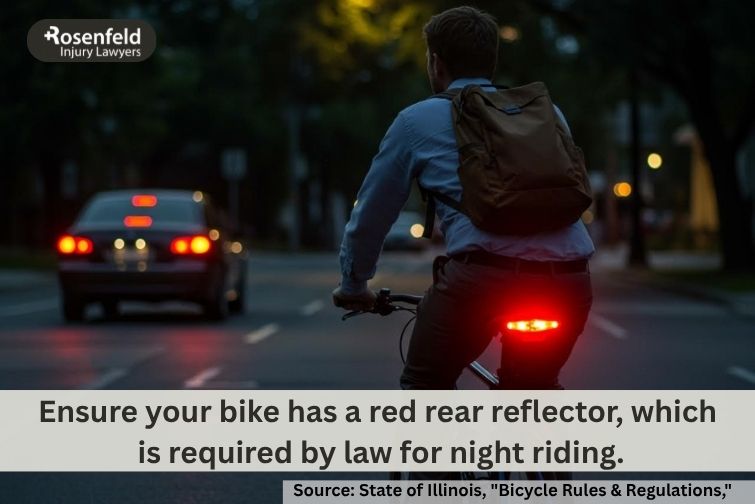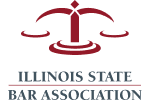Accident Lawyer
How to Prevent Accidents When Riding a Bicycle at Night
Knowing how to prevent accidents when riding a bicycle at night is essential for every Illinois cyclist. Many riders in Chicago and nearby suburbs, whether commuting home from work or enjoying an evening ride along the lakefront, share the road after dark. Unfortunately, reduced visibility, distracted drivers, and poor lighting conditions make night riding especially dangerous.
At Chicago Bike Injury Lawyers, we stand with injured cyclists and advocate for safer riding conditions throughout Illinois, helping riders stay protected whenever they cycle at night.

What Are the Dangers of Cycling at Night?
Cycling at night presents unique risks that don’t exist during daylight hours. Many Chicago-area cyclists, whether commuting home along Milwaukee Avenue or riding through suburban routes near Naperville, face increased danger once the sun sets.
Reduced visibility, tired or impaired motorists, and poor street lighting make nighttime cycling especially hazardous across Illinois, sometimes leading to fatal bicycle accidents when multiple risk factors combine.
Reduced Visibility and Slower Driver Reaction Times
At nighttime, drivers have far less time to react to a cyclist’s presence. A rider may disappear in the glare of oncoming headlights or blend into roadside shadows, particularly where streetlights are sparse. Even with a white front light and red rear light, the narrow illumination beam may not fully outline a cyclist’s body or movement.
This is especially concerning on routes like Ashland Avenue, Western Avenue, and Ogden Avenue, where traffic remains heavy into late hours and side lighting is inconsistent. Reduced visibility gives drivers only seconds to respond, a small window that can mean the difference between avoiding a sideswipe and causing one.
Fatigue Among Motorists
Driver fatigue increases sharply during late-night hours. Tired motorists have slower reaction times and diminished focus, often underestimating the speed of nearby bikes. When combined with dim lighting or glare from headlights, the risk of missing a cyclist altogether grows substantially.
Fatigued drivers are also more likely to drift into bike lanes or make abrupt turns without noticing a rider alongside them, particularly during a left hook or right hook maneuver at an intersection or a crosswalk.
Impaired or Distracted Driving
Evening and nighttime hours see higher rates of drunk or impaired driving. Add in distraction from phones, dashboard screens, or navigation devices, and cyclists face serious danger from drivers whose attention is divided. Impaired drivers often fail to recognize a cyclist’s hand signals, blinking lights, or reflective clothing until it’s too late.
Busy entertainment corridors like Clark Street or Division Street in Chicago are particularly dangerous after dark when nightlife traffic combines with reduced driver alertness. Such conditions frequently contribute to hit-and-run collisions or failure-to-stop violations where negligent drivers flee the scene instead of helping the injured rider.
Poorly Lit Intersections and Bike Lanes
Many bike lanes and intersections around Chicago and its suburbs lack adequate lighting or maintenance. Faded paint, broken reflectors, and malfunctioning signals make it difficult for both cyclists and drivers to identify right-of-way. Dimly lit corridors such as Cicero Avenue, Harlem Avenue, and stretches of Roosevelt Road leave riders vulnerable to cars turning across their paths or failing to yield.
In these dark zones, damaged roads, debris, and parked cars create additional risks of dooring incidents where a driver or passenger opens a door directly into a cyclist’s path. Bad lighting and missing reflectors also heighten the chance of road rage altercations, as frustrated drivers misinterpret cyclists’ defensive maneuvers as erratic behavior.
Combined Risk Factors
Most nighttime bike accidents involve more than one hazard. A drowsy or distracted driver traveling on a poorly lit street may fail to notice a cyclist until the moment of impact. Likewise, a rider swerving to avoid a pothole under weak lighting might inadvertently move into a car’s path. When multiple factors like low visibility, fatigue, distraction, and inadequate infrastructure intersect, the danger escalates sharply.
For those who must ride after nightfall, understanding these risks is the first step toward staying visible, alert, and safe on Illinois roads.
How to Prevent Night-Riding Bicycle Accidents
Knowing the dangers of cycling at night is only half the equation; the key to staying safe is preparation. Following Illinois law, maintaining the right gear, and riding predictably can dramatically reduce the risk of a crash. Whether you’re urban cycling through Chicago or enjoying a late-night trail ride in the suburbs, these steps can help you be visible and protected.
Check Bike Light Battery Life
Before heading out, always check your bike lights and ensure they are fully charged or have fresh batteries, and be well-acquainted with your local regulations.
The Illinois Vehicle Code (625 ILCS 5/11-1507) requires every bicycle operated at night to be equipped with a white front light visible from at least 500 feet and a red rear reflector or red light visible from 100 to 600 feet. These safety essentials make the difference between being seen and being overlooked by passing cars and trucks.
Use two lights if possible, a steady front white light beam for illumination, and a flashing light to draw attention from other road users. Check the battery life regularly, especially in colder weather when charge capacity can drop quickly.
Keep a compact USB charger or spare batteries from a local hardware store in your cycling kit so you’re never caught in the dark with a dead light. A powerful light helps others see you and helps you illuminate road hazards, potholes, and debris before they cause an accident.
Wear Reflective Clothing and Proper Equipment
Even the brightest lights can’t make you visible from every angle. That’s where reflective gear comes in. Reflective vests, sashes, and ankle and wrist bands enhance side visibility so you remain conspicuous to drivers approaching from any direction. Choose reflective clothes that cover key body points like wrists, ankles, and torso, which move dynamically as you pedal and naturally catch headlights.
Equip your bike and yourself with proper equipment before night cycling. This includes:
- A well-fitted helmet (preferably with a helmet light or rear flasher)
- Pedal reflectors and reflective tape on the bike frame
- Mirrors for rear awareness
- Bright clothing suited to the weather conditions
- Smoothly functioning brakes and tires appropriate for wet or rain-slicked roads
Each element adds a layer of visibility and control, helping you stay safe even in bad lighting or unpredictable traffic.
Night Cycling Behavior Tips
Good visibility is only part of safe night riding, and your behavior on the road matters just as much. Follow these practical tips every time you ride after dark:
- Ride predictably: Keep a straight line, avoid weaving between parked cars, and don’t make sudden lane changes.
- Use hand signals: Don’t forget to clearly signal turns and stops early so drivers and other cyclists can anticipate your moves.
- Stay aware of traffic flow: Be cautious of vehicles turning at intersections or drifting into bike lanes.
- Plan your route: Choose well-lit streets and bike paths when possible, and avoid high-velocity roads or industrial areas with limited lighting.
- Adjust your speed: Riding slower gives you more time to react to obstacles, potholes, or emergency situations.
- Don’t rely on your phone: Keep your attention on the road ahead, not on your screen.
- Stay visible: Even at a crosswalk, make eye contact with drivers before proceeding.
By combining high-brightness bike lights, reliable reflectors, and safe riding behavior, cyclists can minimize the risks associated with riding at night. Every step you take to be seen by others and aware of your surroundings helps ensure that your evening rides remain safe, fun, and free from preventable accidents.

What Are Your Legal Options Following a Bicycle Accident When Riding at Night
Even the most careful cyclists can be injured when riding at night. Reduced visibility, distracted driving, and poor lighting often cause serious collisions throughout Chicago and the surrounding suburbs. When a motorist’s negligence leads to your injuries, you have the right to pursue damages in a bicycle accident lawsuit.
Filing a Civil Claim After a Bike Accident
If you were hurt in a nighttime crash, you may be eligible to file a civil claim against the at-fault driver or another responsible party. Illinois law generally gives injured cyclists two years to file a personal injury claim, though exceptions can apply.
Compensation can include:
- Medical expenses and rehabilitation costs
- Lost income or reduced earning capacity
- Pain, emotional distress, and reduced quality of life
- Bike repair or replacement costs
Proving Negligence
To recover damages, your attorney must show that the driver failed to use reasonable care. Common forms of negligence include speeding, distracted driving, failing to yield, or not adjusting for low-light conditions. Our team works with investigators and traffic experts to collect evidence such as crash reports and witness statements that establish fault.
Insurance and Uninsured Driver Claims
If the driver is uninsured or cannot be located, cyclists may still recover through their own uninsured/underinsured motorist coverage. In some cases, additional claims may exist against municipalities for unsafe lighting, poorly marked lanes, or missing signage. An experienced lawyer can identify all potential sources of recovery.
Expert Legal Counsel for Night-Time Bicycle Accidents
At Chicago Bike Injury Lawyers, we provide skilled representation for cyclists injured in nighttime accidents throughout Illinois. Our team investigates crashes, deals with insurance companies, and pursues full compensation for your medical bills, lost wages, and other losses.
We work on a contingency fee basis, meaning you pay no upfront costs and no attorney fees unless we win your case. Contact us today for a free consultation to discuss your rights and learn how we can help you recover after a bike accident at night.
Content reviewed by Chicago bicycle accident lawyer Jonathan Rosenfeld of Rosenfeld Injury Lawyers LLC, who holds negligent drivers, municipalities, and corporate defendants accountable to protect injured cyclists and their families, and is a trial lawyer recognized by National Trial Lawyers, Best Attorneys of America, and the National Association of Personal Injury Attorneys for high-severity injury claims.








